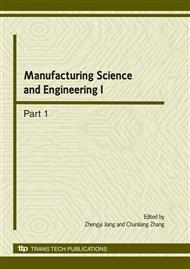p.365
p.370
p.374
p.378
p.382
p.386
p.390
p.395
p.400
Experimental Study on Csf/AZ91D Composite Using Extrusion Following Vacuum Infiltration Method
Abstract:
10vol. % Csf/AZ91D composites were fabricated by extrusion following vacuum infiltration process with self-developed experimental device and measuring system. The relationships of load vs displacement during process and surface quality of composites at various extrusion temperatures were investigated. SEM microscope was used to observe the microstructure of fabricated composites. The experimental results showed that the extrusion process can be divided into three deformation stages. The extrusion temperature had a great influence on the maximum extrusion load. Based on proper infiltration parameters, a extruded bar with good surface quality was obtained at extrusion temperature of 420°C.
Info:
Periodical:
Pages:
382-385
Citation:
Online since:
March 2010
Authors:
Price:
Сopyright:
© 2010 Trans Tech Publications Ltd. All Rights Reserved
Share:
Citation:


